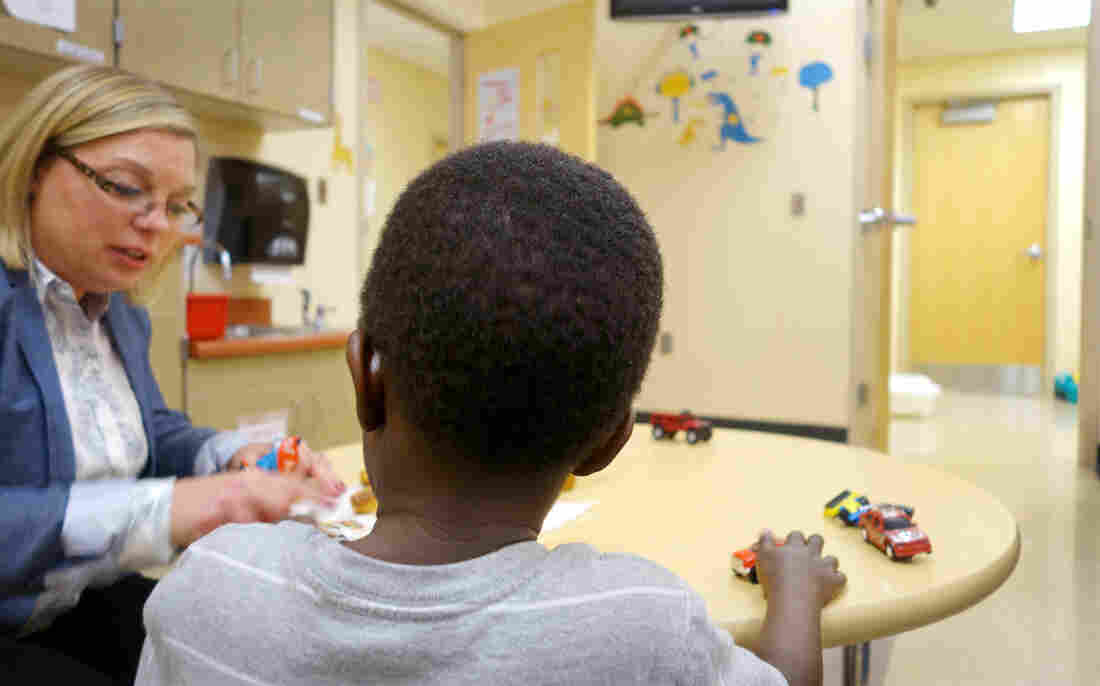By Jake Harper
A young boy talks with Tina Cloer, director of the Children’s Bureau, in Indianapolis. The nonprofit shelter takes in children from the state’s Department of Child Services when a suitable foster family can’t be found. Cloer says the average length of stay at the shelter has increased from two days to 10 in 2015. Jake Harper/Side Effects Public Media hide caption
itoggle caption Jake Harper/Side Effects Public Media
Last year, Erin and Isaac Hougland of Indianapolis got certified to become foster parents, with the hope of adopting a baby. Just a few weeks later, they got a call.
An 8-week-old baby needed a home. All they knew was that the boy’s mother was a heroin addict and had left him at the hospital. They were told that because of the drugs, the baby might require some special care. But mostly, he just needed a place to go.
“Both of us were just like, ‘Let’s do it,’ ” says Isaac Hougland. “We wrapped up what we were doing at work and went to the hospital.”
The Houglands’ foster son is part of a new national influx of kids coming into foster care because parents abusing heroin or prescription painkillers can no longer care for them.
A recent report by the federal government shows that, after years of decline, the number of children in foster care is going up again. Roughly 265,000 kids entered foster care last year — the highest number since 2008.
Between September of 2013 and September of 2015, Indiana saw the number of “children in need of services” jump by 40 percent. In more than half of new cases in which children had to be removed from their homes, substance abuse was listed as a reason. As in other states (such as nearby Ohio), officials in Indiana blame heroin and prescription painkillers.
The increase is taxing the child welfare system, officials say. Children of addicts often need special care and counseling, and they often stay in the system longer because it can take months or years for their parents to get clean.

Marilyn Moores, a juvenile court judge in Indianapolis, says many case managers and court employees are feeling overwhelmed with the rising number of child welfare cases they’re seeing. Jake Harper/Side Effects Public Media hide caption
itoggle caption Jake Harper/Side Effects Public Media
“We have more children than we’ve ever had in our system in Indiana,” says Mary Beth Bonaventura, director of the state’s Department of Child Services. “That puts a stress on the staff, a stress and strain on providers.” And it’s increasingly a challenge, she says, “to find and recruit and train qualified foster families.”
If the Houglands hadn’t provided a home for their foster son, he might have ended up at an emergency shelter like the Children’s Bureau, a nonprofit in Indianapolis. The organization takes in kids from the Department of Child Services when a foster family can’t be found quickly.
“Kids come in here 24/7,” says Tina Cloer, who directs the Children’s Bureau. “So we accept kids all day and all night, and we get calls all day and all night.”
The shelter has been full more often this year, she says, as it has become harder to find kids foster homes. Last year, the average stay was just two days — now, it’s 10. “We have kids that have been here as long as 2 [or] 2 1/2 months,” Cloer says.
The large number of cases burdens other parts of the system, too.
Indiana’s Department of Child Services has a burnout problem: It has lost about a quarter of its case managers in the past year.
“I’ve had a case where we’ve had nine case managers on it — in a year,” says Marilyn Moores, a juvenile court judge in Indianapolis. “That’s the far end, but it’s not unusual to have three or four.”
This year, the child services department started a counseling program for employees, in hopes of retaining more case managers. And the state approved the hiring of 230 more people, but finding and training them will take time. Recruiting can be tough, says Bonaventura.
“If you don’t recruit the right people, they’re out the door the minute they realize how stressful and how gut-wrenching this work is,” she says.
Meanwhile, as the number of cases rises, Moores says, the stress continues to mount for everyone involved, including court employees.
“It just reached a point where every system partner involved in this that I’ve talked to in the last week, when I’ve talked to them, at some point they get tears in their eyes,” she says. “They are just overwhelmed.”
After more than a year of waiting, Erin and Isaac Hougland are looking forward to finally adopting their foster son. But it might take a little longer than usual. Adoption paperwork is piling up, too.
This piece comes from Side Effects Public Media, a public radio reporting collaborative that explores the impacts of place, policy and economics on health.
This entry passed through the Full-Text RSS service – if this is your content and you’re reading it on someone else’s site, please read the FAQ at fivefilters.org/content-only/faq.php#publishers.
